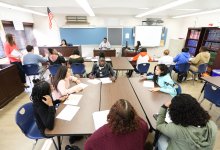Social Studies/History
Explore and share tips, strategies, and resources for helping students develop in the social sciences.
Increasing Participation With Individual Whiteboards
When an entire class uses mini whiteboards to make thinking visible, teachers can be confident everyone is focused on the task at hand.Your content has been saved!
Go to My Saved Content.5 Movement-Based Social Studies Activities
Introducing movement into lessons can help students maintain focus and attention and boost engagement in learning.7.6kYour content has been saved!
Go to My Saved Content.Evaluating Primary Sources Through a See, Think, Wonder
By taking the time to observe, make inferences, and ask great questions about historical artifacts and images, students learn to avoid jumping to conclusions.Scaffolding Discussion Skills With a Socratic Circle
Students deepen their understanding and build a sense of community by engaging with their peers’ reasoned arguments.242kYour content has been saved!
Go to My Saved Content.Inquiry-Based Tasks in Social Studies
Assignments that are bigger than a lesson and smaller than a unit are a good way to experiment with inquiry-based learning.208.1kYour content has been saved!
Go to My Saved Content.Using Staging Activities in Social Studies to Build Engagement
Effective staging lessons help make a new unit seem relevant to students and also set the stage for critical thinking.9.8kYour content has been saved!
Go to My Saved Content.Getting Their Hands Dirty
Experiential learning—like making incense sticks in factory conditions—teaches kids about real social issues.192kYour content has been saved!
Go to My Saved Content.6 Free Online Resources for Primary Source Documents
The Common Core Learning Standards describe the importance of teaching students how to comprehend informational text. Primary source documents are artifacts created by individuals during a particular period in history. This could be a letter, speech, photograph or journal entry. If you're looking to integrate social studies into your literacy block, try out one of these resources for primary source documents.301kYour content has been saved!
Go to My Saved Content.AI Tool Demo: Canva’s Text-to-Image Generator
Assistant editor Daniel Leonard shows how teachers are using Canva’s AI image generator to create fun writing prompts and engaging history-oriented images.Project-Based Learning: Raising Student Achievement for All Learners
Researchers in Michigan showed that project-based learning in high-poverty communities can produce statistically significant gains in social studies and informational reading—see how they did it in this video.206.8kYour content has been saved!
Go to My Saved Content.AI Tool Demo: Creative Uses for ChatGPT in History and ELA
Assistant editor Daniel Leonard shares a few interesting applications of ChatGPT that teachers have adopted to drive critical thinking and deeper analysis.Using Secondary Sources in High School History
Teachers can use differing interpretations of historical events to help students move from memorizing events to analyzing and interpreting them.876Your content has been saved!
Go to My Saved Content.Setting Up an Engaging Launch for a New Unit in Middle School
By encouraging students to think deeply at the beginning of units, teachers can help them see why the material is relevant to their lives.4.2kYour content has been saved!
Go to My Saved Content.Talking Politics: Valuing Different Perspectives
Students learn how to share and listen to opposing beliefs with empathy.157.3kYour content has been saved!
Go to My Saved Content.Reinventing AP Courses With Rigorous Project-Based Learning
A new study shows that when implemented well, AP courses built around project-based learning can raise test scores for all students, including those in traditionally underserved demographics.92.1kYour content has been saved!
Go to My Saved Content.














